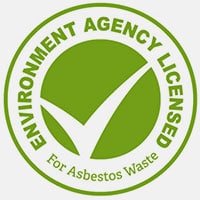Frequently Asked Questions About Asbestos
Find out about asbestos, what is is and why it is a hazardous material.Additional to this if you are looking for information and guidance, the following link will take you to out Health & Safety Executive Free Guidance and Information Page. Here you will find helpful asbestos essentials guides which may be useful:
Frequently Asked Questions
Below are some of the most frequently asked questions about asbestos removal services. If you cannot find what you are looking for try our ‘about asbestos’ section of the website, or ‘contact us’ with your question and we will be happy to help.
What is Asbestos?
Asbestos is the name given to a group of naturally occurring silicate minerals, which are exploited commercially for their individual properties, such as high tensile strength and resistance to chemical erosion.
There are six types of asbestos, the three below are most commonly found in the UK:
- Crocidolite (Blue)
- Chrysotile (White)
- Amosite (Brown)
The other three types (Fibrous Actinolite, Tremolite and Anthophylite) can be found in the UK but were not commonly used in the majority of building products. Asbestos was frequently used in building materials from the 1950’s through to the 1980’s.
Learn more on what is asbestos…
I only rent the property, so who is responsible for managing the asbestos?
The legislation says that merely controlling access to non-domestic premises makes you a “duty holder”. So you are still responsible under the law. There can be more than one duty holder, you may need to discuss your responsibilities with your landlord as it will depend on your lease agreement.
Learn more on direct asbestos law…
How likely is it that I will have asbestos containing materials within my building?
Unless you occupy buildings built after 1999 when all asbestos was banned in the United Kingdom, you cannot be sure that your building does not contain asbestos and must be presume so unless proven otherwise by an asbestos survey.
Learn more on asbestos surveys…
Can we locate asbestos within our buildings ourselves?
Following an asbestos survey we will undertake analysis within an accredited laboratory, provide you with a survey report and asbestos register; and advise on condition and risk. We will suggest appropriate remedial action; and if needed can consult with you on your asbestos management plan.
Learn more on asbestos management…
Do plans of my premises need to be available for a survey?
Learn more on asbestos surveys…
Can surveys be carried out outside of normal business hours?
Most professional asbestos survey consultants like Oracle Solutions, can work outside normal business hours if required.
What happens during a survey?
The asbestos survey will start with the surveyor asking questions about the age of the premises, dates of any refurbishment etc. this will give clues about the types of materials used. A site plan will be marked up to identify sample positions as the asbestos survey progresses. Each area of the building will be inspected in minute detail for signs of asbestos containing materials. Any suspected materials will be noted and samples taken if judged necessary by the surveyor.
The asbestos survey if done correctly will take a few hours minimum onsite time, to several days on larger projects. Once the site work is over, the surveyor will send samples off for analysis and on return of the results, write the asbestos survey report. Do not be tempted to go for the lowest cost – it is essential that the job is done properly and can’t be done in ten minutes!
Learn more about asbestos surveys…
Do I need to remove the asbestos that the survey identifies?
No not necessarily, if properly managed asbestos containing materials can remain in-situ, it will depend on the type of asbestos, its condition, its location, its extent, the occupancy of the area concerned and any future plans which may affect the asbestos containing material etc. So the decision to remove asbestos, encapsulate or simply manage asbestos is based on a risk assessment best made by professionals like Oracle Solutions.
Learn more on asbestos surveys reports and registers…
What is the Government tax incentive?
For example, if £50,000 is spent on removing asbestos, £75,000 can be deducted from the property owner’s taxable profits. It is also possible that part of our professional and survey fees and possibly, depending on the nature of the project, the reinstatement expenditure may also qualify.
Relief can be claimed on expenditure incurred from May 2001 but there are restrictions, including a requirement that those claiming relief were not the original polluters of the land. The claimant must also be a UK registered company.
The tax relief may improve the options when considering what actions to take when dealing with remediation of asbestos. The relief obviously should not determine the action taken, but any possibility of claiming it on replacement materials may change long-term objectives. The tax relief initiative is a major financial help for businesses. There are exclusions, so check with your accountant for specific advice.
Which occupations have the highest risk of exposure to asbestos?
Based on an analysis of the deaths from 2002 – 2005 the ten occupations found to have the highest risk of mesothelioma for males were Carpenters, Plumbers, Electricians, Labourers in Other Construction Trades, Metal Plate Workers, Pipe Fitters, Construction Operatives, Managers in Construction, Construction Trades and Energy Plant Operatives.
The highest mesothelioma risk today is seen in occupations predominately associated with construction and building maintenance, highlighting a shift away from the traditional asbestos exposure industries of the past such as shipbuilding and railway engineering.
What does the Duty Holder have to do to comply with the new legislation?
The new duty to manage requires the duty holder to take reasonable steps to find asbestos in the premises and assess the condition of these materials. The duty holder must:
- presume that materials do contain asbestos unless there is strong evidence that they do not;
- prepare a record of the location and condition of these materials and assess the risk from them;
- prepare and implement a plan to manage those risks; and
- provide information on the location and condition of the material to anyone who is liable to disturb it.
Who needs to know where Asbestos is?
The legislation requires that the duty holder, make information on the location and condition of asbestos available to anyone liable to work on it or disturb it. Any employees involved in building maintenance work and any contractors working on the premises should know if the building contains or may contain asbestos. They should also be told where it is and that there are potential risks to their health if they disturb it.
Do I need to have training to manage my asbestos?
Regulation 10 of the Control of Asbestos Regulations 2006 indicates that asbestos awareness training must be undertaken for trades who are liable to disturb asbestos while carrying out their normal everyday work, or those who may influence how work is carried out.
The regulation then lists the following trades, maintenance staff, electricians, plumbers, gas fitters, painters and decorators, joiners, plasterers, demolition workers, construction workers, roofers, heating and ventilation engineers, telecommunication engineers, fire and burglar installers, shop fitters, computer installers, architects, building surveyors and other such professionals.
Is there a safe level of exposure to asbestos below which there is no risk?
No
Mesothelioma
There is a lack of scientific consensus as to whether there exists a threshold of exposure to asbestos below which a person is at zero risk of developing mesothelioma. However, there is evidence from epidemiological studies of asbestos exposed groups that any threshold for mesothelioma must be at a very low level – and it is fairly widely agreed that if a threshold does exists then it cannot currently be quantified. For practical purposes HSE does not assume that such a threshold exists.
Learn more about mesothelioma…
Asbestosis and lung cancer
The situation for lung cancer and asbestosis is uncertain. Arguments for a threshold for lung cancer are based on the notion of the carcinogenic process being an extension of the chronic inflammatory processes producing fibrosis. It is generally recognised that heavy doses of white asbestos are required to produce clinically significant lung fibrosis. However, the situation for blue and brown asbestos is more uncertain and fibrosis has been observed at much lower exposures. This also suggests that if a threshold for lung cancer does exist for blue and brown asbestos it must be at a very low level indeed.
Learn more about Asbestosis and lung cancer…

 "There are lots of guarantees around. Here's my simple guarantee: If there's something wrong, we'll fix it."
Jess Scott - CEO
"There are lots of guarantees around. Here's my simple guarantee: If there's something wrong, we'll fix it."
Jess Scott - CEO

















